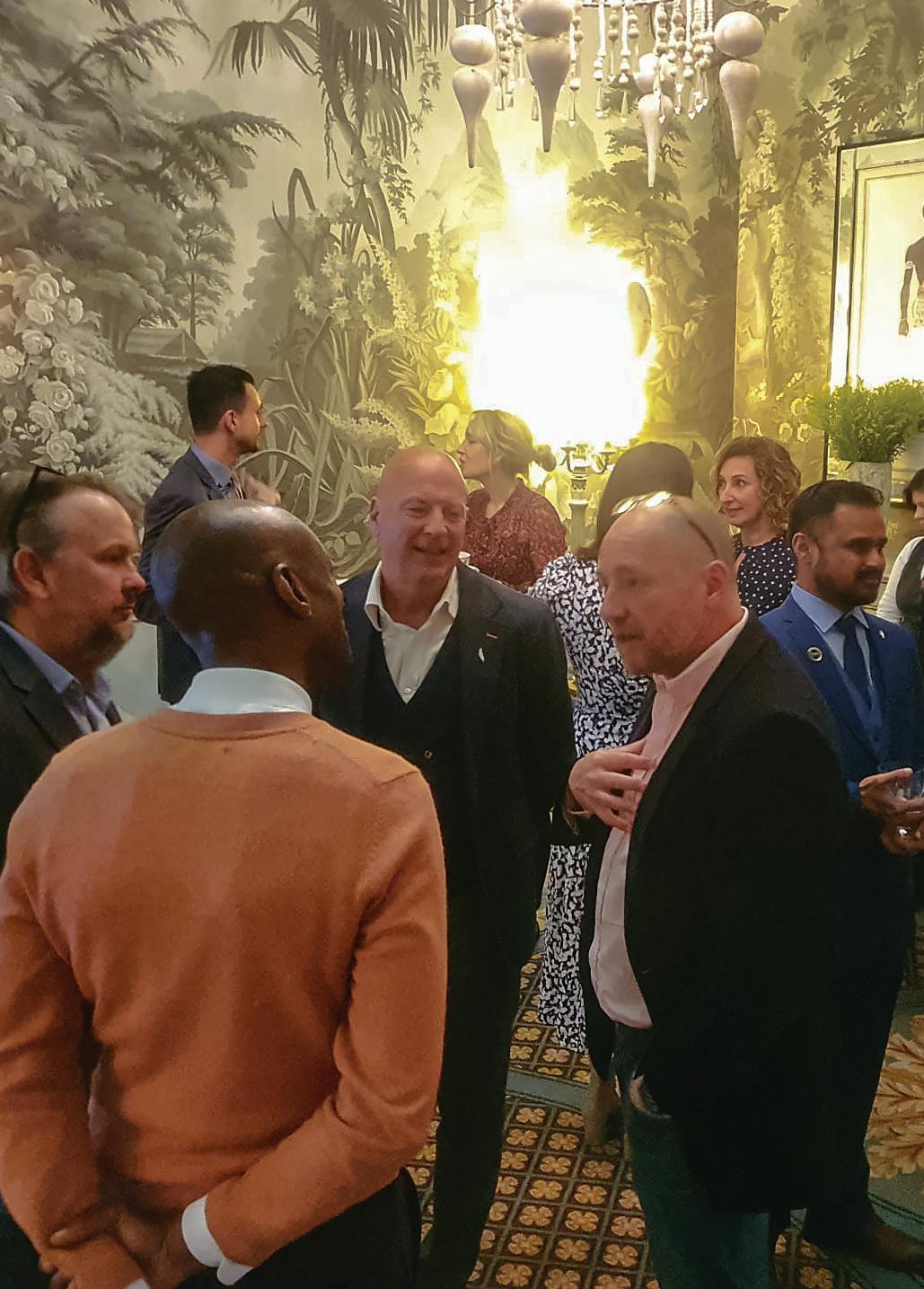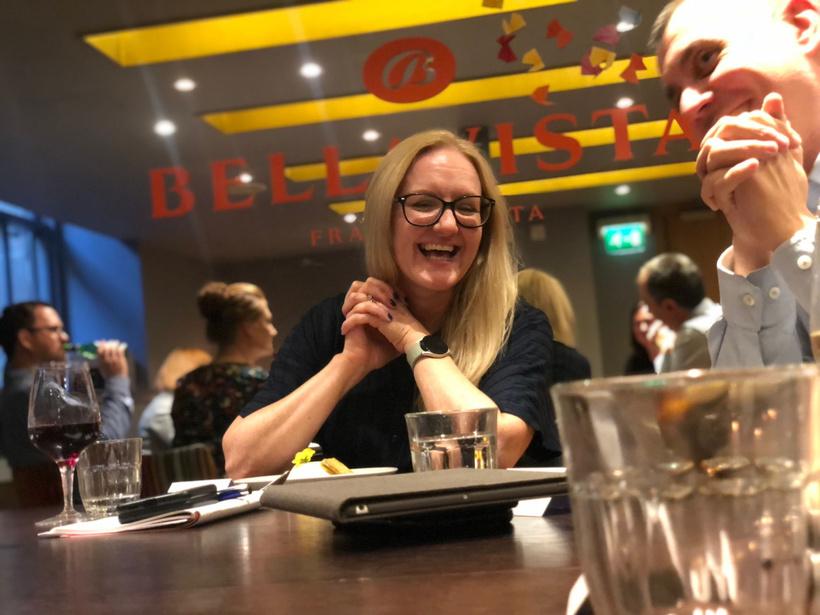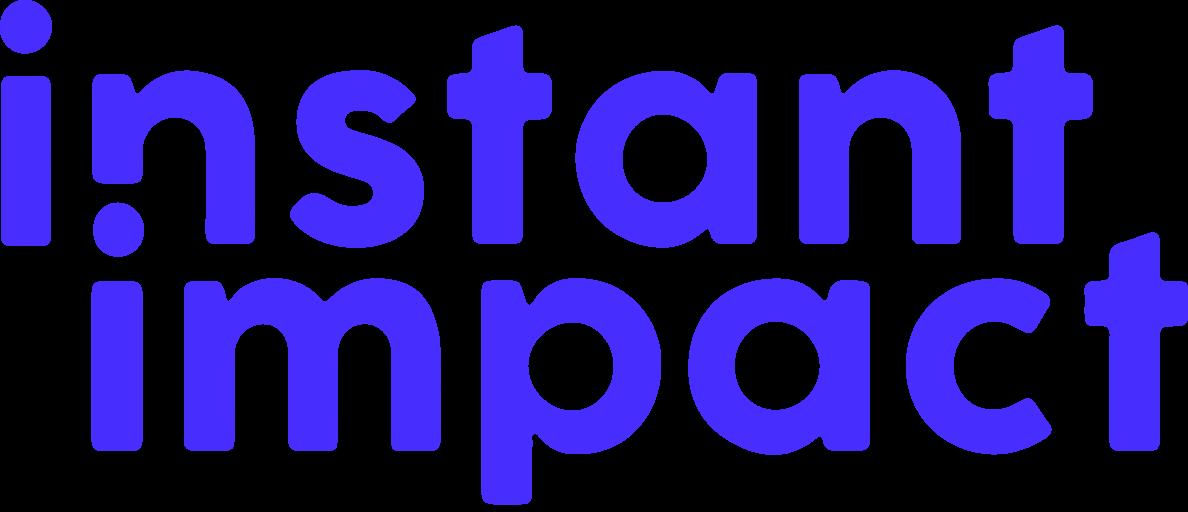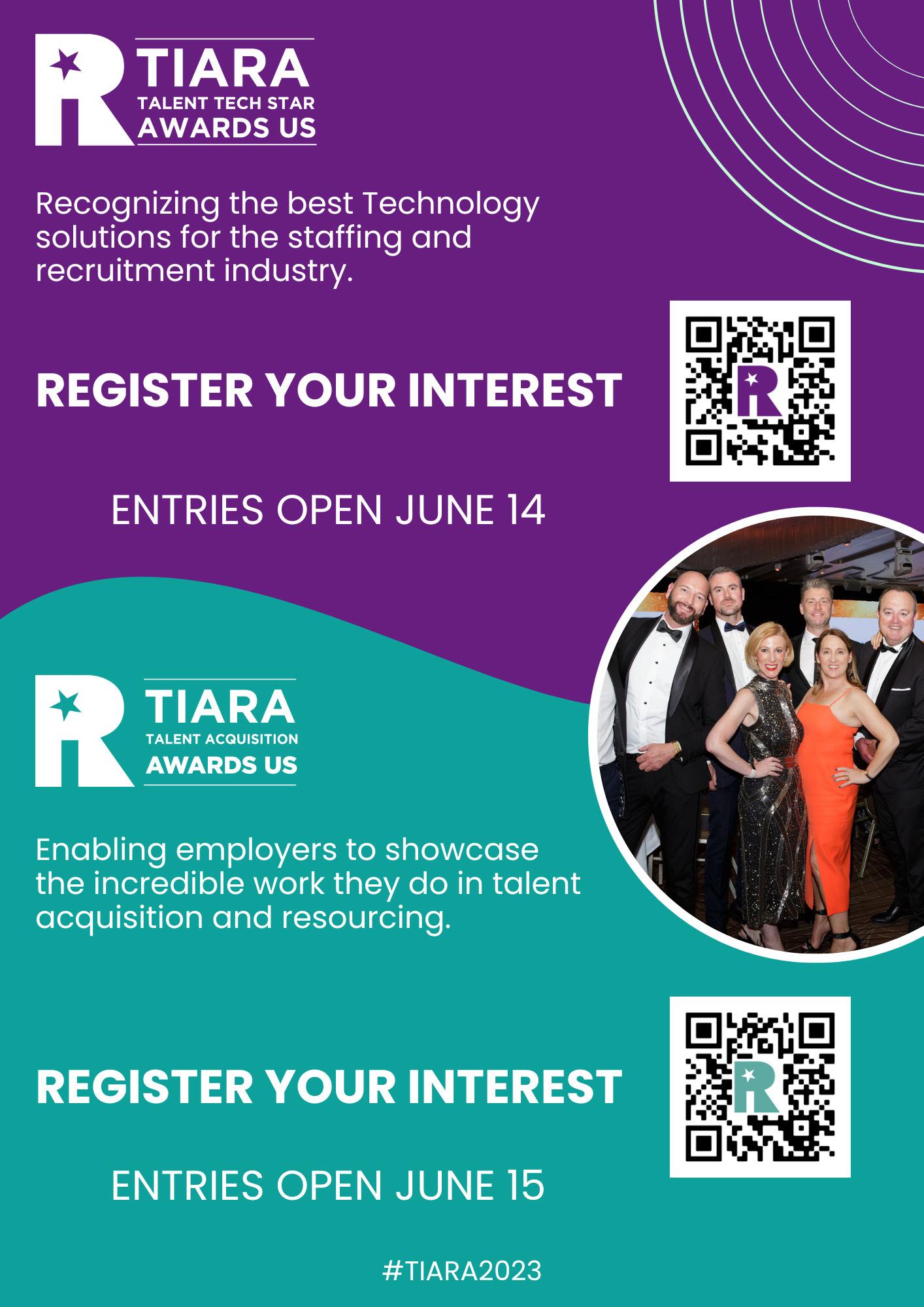THE ROAD TO DIVERSITY
Elevating gender parity in the workplace
THE POWER OF
CONNECTION
Instant Impact, Chief Growth Officer

Pete Donaldson on the hunt for data in TA
DEATH OF THE CV? OR ITS EVOLUTION?

Elevating gender parity in the workplace
CONNECTION
Instant Impact, Chief Growth Officer

Pete Donaldson on the hunt for data in TA
DEATH OF THE CV? OR ITS EVOLUTION?
Dasro’s powerful network of contractors has the technical expertise, professionalism, and reliability you need to reach your goals.

Talk of a digital way of life is dominating the news! Digital currency, the metaverse and digital ID are taking center stage. And while the UK is charging ahead with digital ID, the Digital ID Bill was passed through the US Senate in early April.
What’s different in the US however, is that digital ID primarily will not be used to speed up hiring as it is in the UK, but more to verify online identity to limit criminal behavior. The Bill was introduced in response to a call from the bipartisan Commission on Enhancing National Cybersecurity for federal agencies to act as “an authoritative source to validate identity attributes” across the digital ID market. If it is passed, an Improving Digital Identity Task Force would be established to help ensure citizens’ privacy and security. The UK has no such bodies set up – yet.
The passing of the Improving Digital Identity Act to the next stage of debate follows the leak (ironically) in February of the draft terms of a draft executive order which outlined that the
About TALiNT Partners
TALiNT Partners brings together a global network of leading employers and solution providers to make better talent and technology decisions by providing intelligence, insight and peer-to-peer networking that drives quality, innovation and improves inclusion across the talent ecosystem.
 Debbie Walton Editor, TALiNT Partners
Debbie Walton Editor, TALiNT Partners
US federal government’s Login .gov digital identity service could be expanded nationally. The legislation’s passage joins nearly two dozen critical cyber bill approvals, including the bipartisan Securing Open Source Software Act, which would legally bind the federal government to protecting open-source software like ChatGPT.
But the gist of it on both sides of The Pond is that the Digital ID is going to be far more commonplace and while it’s starting out as simply identity verification, it will undoubtedly evolve into so much more. Read the full feature on the Digital ID and how it will facilitate the evolution of the CV on page 12.
Also in this issue is an interview with TalentNet President and Co-Founder, Jonathan Prothero about how they leverage AI to enhance the candidate experience. Read the full interview on page 19.
Editorial, news and features: debbie@talintpartners.com

Advertising and sponsorship: andy@talintpartners.com
Layout and design: New Media Design Agency www.newmediadesign.co.za













According to a recent report by FreshBooks, the impact of artificial intelligence (AI) on organizations continues to grow, with 25% of small businesses currently utilizing or testing generative AI tools. Encouragingly, two-thirds of these businesses plan to explore these tools for their work within the next 12 months. The report surveyed 1,000 small-business owners from diverse industries in the United States and Canada during May.
The findings suggest that small-business owners are not overly concerned about AI replacing their roles, as only 44% of respondents anticipated hiring fewer people in the future due to the capabilities of AI.
The survey revealed that the majority of current generative AI adopters are employing it for text generation purposes, while others are leveraging its abilities to create images or conduct general business research. Most respondents reported using AI-generated content on their business websites and social media platforms. However, fewer participants stated that they utilize generative AI content for customer support and communications.
Regarding the impact of AI on their businesses, 60% of respondents believed that AI would bring about significant changes within the next five years. The areas expected to be most affected include business analytics, sales and marketing, and customer communications, according to the report. On the other hand, respondents rated human resources, recruiting, and service delivery as the areas least likely to be impacted by AI.
Despite the growing adoption of AI, privacy, ethical concerns, and intellectual property issues were significant points of worry for 80%
of small-business owners. This demonstrates a recognition of the potential risks associated with AI implementation.
Overall, the FreshBooks report highlights the growing acceptance and optimism surrounding the use of generative AI tools among small businesses. As these businesses explore AI’s potential to support their growth, they remain mindful of the ethical and privacy considerations associated with this technology.
25%
Number of small businesses using AI
44%
Number of people anticipating fewer people because of AI
60%
Number of people who believe AI will significantly change the way we work in the next 5 years
Employers are currently confronting a crucial moment when it comes to focusing on environmental, social, and governance (ESG) issues, driven by the societal, geopolitical, and economic challenges of recent years. With workplace flexibility, equity and diversity, and the pressing climate crisis at the forefront, companies are under increasing pressure to take meaningful action. ESG has become not just a moral imperative but also a business necessity. While sustainability initiatives have dominated the ESG conversation, attention is now shifting towards the social aspect, encompassing the goals companies establish, monitor, and share.
In the year 2023 and beyond, there are three key social areas that companies should prioritize. The past couple of years have blurred the boundaries between personal and professional lives for many of the 160 million individuals in the U.S. workforce, leading to feelings of isolation and widespread burnout. Disturbingly, in 2022, 2 out of 5 workers reported that their mental health had been negatively affected by their work environment. High levels of stress among employees can result in increased absenteeism and reduced engagement, ultimately impacting a company’s bottom line.
Fortunately, by prioritizing mental health and personal development, employers can foster a positive cultural shift. Implementing initiatives like “mental health” or “no meeting” days, wellness breaks, and short-term disability coverage can significantly boost company morale. Particularly during uncertain times, building a culture of trust and flexibility has been proven to enhance employee engagement, productivity, talent retention, and overall satisfaction.
Equality, diversity, inclusion, and accessibility have long been essential targets for most companies’ social goals. It has become customary for companies to collect and disclose data on how they ensure equality across racial, cultural, generational, gender, and other dimensions, including intersectionality. Astonishingly, 76% of job seekers consider a diverse workforce when evaluating potential employers. Diverse companies experience 2.5 times higher cash flow per employee, and those that prioritize gender diversity are 15% more likely to surpass their industry’s median financial returns.
Mentorship and sponsorship are powerful tools to bolster employee morale and engagement. Recent research indicates that inclusive mentorship programs play a pivotal role in attracting and retaining diverse talent, with women and minority groups recognizing the value of mentorship and sponsorship in their career development. It comes as no surprise that companies aiming to ‘make a difference’ will continue to play a significant role in 2023 and beyond. Employees and consumers expect the companies they support to stand for something, with 70% stating that their sense of purpose is derived from their work.
Companies must leverage employees’ sense of purpose to guide executive decisions and track the progress of their commitments. Employees need to see their leaders not only talk about these values but also act upon them. Initiatives that are easy to implement, such as volunteer days, fundraisers, donationmatching, and environmental pledges to combat the climate crisis, exemplify mutual aid and can greatly benefit a company’s workforce as well as the planet.
TALiNT Partners events give attendees unrivalled access to industry experts who lead conversations around trends and challenges currently faced by TA teams, staffing and tech firms from across the talent ecosystem. They offer a wonderful opportunity to network and learn while feasting on delicious meals and enjoying fine wines.
11 May
TALiNT Partners hosted leaders in the recruitment space and spoke about AI in recruitment and how it is impacting the industry now, and in the future.

AI is already enhancing recruitment, and the better use of data and analytics is enabling recruiters to be more effective, predictive and grow more profitably. This compelling theme was discussed over a delicious dinner in the Art Deco-inspired Long Room.


The Gibson Hotel, Dublin, Ireland

TALiNT Partners’ Ireland TA Leader’s summit looked at the big talent issues facing employers in 2023. The Gibson, owned by U2’s Bono, was a great venue to host this event. The drum cymbols on the ceiling are real Gibson cymbols and apparently help with the acoustics of the room – we are sure the guests heard every word of this dynamic and interesting workshop.

As the world of work evolves, organisation are exploring new avenues to harness and develop talent in every form it takes. And when it comes to confident decision-making there is nothing more enabling than great insight.

TALiNT Partners hosted the High Growth Lunch & Learn in the Shooting Room at the Haymarket Hotel in London. Panellists included Denise Walker, Founder and Director of Absolutely Business, Tim Cook, Group CEO at nGage and Geraint Rowe, Partner at Gambit Corporate Finance.



TALiNT Partners and Guidant Global headed north to host a dinner for talent acquisition leaders at the lush The Ivy – one of our favourite venues. The theme for the night’s discussion was shaping talent in an evolving world of work and building a contingent workforce with DE&I. Some of the critical questions asked covered harnessing to power of data to shape your organisation’s DE&I strategy and the crucial role your MSP can play in the success of contingent led DE&I initiatives. It was a great night where both good food and knowledge were consumed.



Recruiters and employers have been talking about the death of the CV for decades, but until now, there’s never been a suitable replacement. Sure, LinkedIn profiles provide some of the information needed to make informed hiring decisions about a candidate, and now with the advancement of Talent Intelligence hi�ng the hiring market, is the Digital ID, finally the death of the CV?
At the start of the pandemic, major adjustments were made to Right to Work (RTW) checks and a shift towards online identification verification became the norm. Fast forward three years, numerous meetings of parliament and toing and froing between axing digital RTW checks and keeping them, in October 2022, the government decided that since Digital ID (DI) verification met all the legal requirements needed to roll it out, it was here to stay. With one caveat: employers had to choose one or the other form of ID checking potential employees.
Digital Identity in the employment sector has become the star use case for its implementation.

Reed Screening Group Risk Director, Keith Rosser is on a mission to create a safer world of work; safer for workers, for work seekers and employers and has been the main driver and fierce evangelist for the approval and adoption of the DI.

“UK hiring can be a shining example to the world” Keith told a Commons Committee a few weeks ago on DI. He said that DI and the provision for greater government data sharing through the Data Information Bill can help make “UK hiring the fastest globally”.
But is the roll out of the Digital ID the death of the CV? This question has been debated for years and while some will say it’s time to axe the CV, there are others who are still very much in favour of keeping it.

As it is today, DI allows for RTW checks and offers the capability to prove that a person is who they say they are. But in terms of what could be added to it will depend on whether the Data Protection and Digital Reform Bill gets passed in Parliament. As mentioned before, DI in employment has created the best use case and additional information that could be added to the DI may include HMRC payroll records, for example, where a candidate worked, how long they worked there and how much they earned. Taken a few steps further, information on qualifications, payroll data and more, this could potentially exclude the use of CVs altogether. But this poses certain privacy infringement issues because candidates legally don’t have the disclose salary figures to potential employees.
“The process around DI is all consent-led and will always be so,” said Keith. “Right now, if you go on the HMRC gateway and look somebody up with their consent you can access all that information already. But it’s imperative we hard-wire consent into the process.”
This, however, can lead to some ethical hiring concerns. What would happen if a candidate doesn’t give consent to these checks, but another candidate in the running for the same role does? Would the recruiter choose the candidate who gives consent simply to speed up the hiring process?
Another ethical concern is that the DI could potentially turbocharge the recruitment by Artificial Intelligence debate. “Imagine we eventually just end up with a few robots that takes care of all hiring? Candidate X applies for a job and gives consent; the robot carries out the checks and decides whether Candidate X is more suitable than Candidate Y, and chooses the candidate who gave consent. It does sound a bit space age, but I don’t think it is,” commented Keith.
“We need to start thinking about hardwiring in the right to have a human make the final decision on candidate suitability for a role”, he added.
The process around DI is all consentled and will always be so, Keith Rosser , Reed Screening Group Risk Director
This leads to significant concern about the potential for discrimination and not only about who does or doesn’t give consent.
Qualifying documents to use for DI are reserved for those who hold work visas and in-date British and Irish passports. “This clearly creates a second-class job seeker because all of a sudden, whilst it’s illegal to discriminate, if two job seekers present themselves for a role and only one can go through the digital system when the company wants someone to start next week; it’s likely the recruiter or employer will choose the candidate who can go through a RTW check in three minutes and is ready to start the next day, and not the candidate who can only make a three-hour commute to ID verification in three weeks’ time,” said Keith.
Jo Major, Founder at Diversity in Recruitment said, “Adopters must consider accessibility in design. Systems must be made available for
everyone, and physical, cognitive, and technological limitations must be carefully considered. As with all technology, there must be an alternative as we cannot find ourselves in a ‘computer says no situation.’”

But who are the DIs currently excluding?
Companies can still shortlist and interview candidates before conducting identity checks if they choose to do so. However, adopting immediate identity checks makes blind recruitment difficult unless the company has robust practices in place. Interestingly, the current digital system disproportionately affects white British individuals who lack an in-date passport, while newer generations and immigrants often possess right-to-work clearance, leading to unintended harm to certain groups. Social exclusion and the issue of diversity primarily affect economically disadvantaged individuals, including poor white individuals and various ethnic groups.
There have been interesting questions raised regarding intergovernmental data sharing, including employment history, pay, and qualifications. It’s also highlighted the importance of interoperability between governments, where the digital identity from one country can be used in another. Keith questioned the need for individuals to repeat the digital identity verification process when applying for jobs with different companies. There are challenges in achieving commercial viability and addressing concerns of the identity service providers who may see reduced profits but the issues of reusability and interoperability across governments, along with sharing additional government data, pose significant questions that need to be answered.
Keith suggested that consent should be built into the system to address these concerns and ensure individuals, like temporary and contract workers have control over their identities. Limiting the distribution of personal data is crucial, as civil liberties groups raise concerns
about maintaining control over identity information. Furthermore, there are challenges for employers, as the traditional method of storing physical documents no longer applies. With a candidate’s digital identity stored in a recruitment firm or employer’s data system, regulations must be established to ensure proper usage, preventing unauthorised resale or forwarding of the information. Privacy concerns arise as the organisation in question could potentially hold a significant number of digital identities on its platform.

One would think that digital verification could partially address identity theft, assuming no major hacking incidents occur. A positive trend is being seen where technology successfully detects fraudulent documents. However, the crucial concern lies in what happens next.
Anecdotal evidence suggests that individuals whose fake documents are identified by digital systems, may resort to alternative methods. They approach companies directly or send physical documents to bypass the digital route, knowing that the system would expose their falsified identity. This shift in tactics transfers the problem to individuals who are aware of
their fake documents and intentionally exploit face-to-face or postal channels to secure employment. While the current system flags more fakes, it does not effectively eradicate the issue of identity theft.
Julieanne Fouad, Director of Sales at IMS People Possible believes, however, that the digital ID could address the issue of fraudulent documents. “Using digital identity technologies, employers can now rely on certified providers to conduct thorough pre-employment checks, including criminal record verifications. This will significantly reduce the risk of hiring individuals based on falsified credentials. Suppliers with accredited services can also do Digital Disclosure and Barring Service identification checks, right-to-work, and right-to-rent checks for British and Irish passport holders.”
The Digital ID, as it is today, is simply a Right to Work check but with much greater potential to house an online CV of sorts. While there are clearly many creases left to iron out, the positive affects it could have on recruitment process in the UK are undeniable. Digital identification confirms the hard facts, but the CV and in-person interactions with candidates during the hiring process will continue to enable TA teams to build a rapport with candidates and identify the softs skills that will determine whether they’d fit into the culture of the business etc.
Darren Topping, Director of Solutions and Insights at Lorien Global believes that despite the death knell tolling loudly over the years, the CV still is alive and well.
 Major, Founder at Diversity in Recruitment
Major, Founder at Diversity in Recruitment
Recruitment technology can and does limit our opportunities to reach everyone
Jo
“Rightly or wrongly, and regardless of the arguments against the CV, most organisations, and in particular the people that keep it alive – hiring managers – rely on this detailed profile of a person to truly bring to life their achievements, job roles and capabilities.”

In specific industries, where mass hiring is taking place, such as the NHS, the pros of DI are undeniable. Julieann said that the introduction of digital identification could revolutionise the hiring process, particularly in a skills-strapped sector, like the NHS. By providing a secure and verifiable online link to an individual’s qualifications, it can expedite the screening and selection of candidates, saving valuable time and resources.
Jo Major said that just because we are in a race for recruitment to become faster, slicker, and more immediate in everything, we are
inevitably and without realising, excluding some groups. “Recruitment technology can and does limit our opportunities to reach everyone, it can cause missed perspectives in assessment, amplify bias and preference, and can we fail to spot much-needed adjustments and accommodations. As with any form of technology that learns from predetermined rules, machine learning and algorithms, we must check, recheck and continue to recheck for bias that makes life easier for one group but creates barriers for others.”
Taking into consideration the speed at which technology is evolving – one only has to think of ChatGPT – a Digital ID housing a full scale, all-encompassing CV could very well be just around the corner but where we are now and what it is currently used for, it’s easy to see that it’s not the death of the CV, but simply its evolution.

TI: TalentNet defines itself as one of (if not ‘the’) Direct Sourcing OGs. What sets you apart from the rest?
JP: As the originators of Direct Sourcing, we understand how quickly the talent acquisition landscape can change and the importance of always evolving. That’s why we created our One Doorway to talent, that allows companies to connect with a wide variety of candidate types through a single solution.

Our TalentNet team continually works to improve our solution using the latest machinelearning and AI technology, creating a more seamless experience both for candidates, companies and recruiters alike. We are actually currently implementing two new platforms: TalentConnect, which allows hiring managers and curators to communicate more effectively, and TalentMobility, which encourages current workers to register into a talent pool and apply for open roles within the organization allowing them to create their own career path.
Through our years of broad experiences, we’re able to develop innovative strategies that are tailored to each client’s unique challenges, resulting in impactful results to their workforce.
TI: How does using talent intelligence shape your clients’ offerings?
JP: Our ability to utilize the latest data collection analytics allows TalentNet to understand hiring challenges in different industries, as well as what candidates are looking for ¬which is the ability to develop their own flexible career journey.
TALiNT International sat down with Jonathan Prothero, President and Co-Founder at TalentNet to talk about how they leverage the latest machine-learning and AI technology to enhance the candidate, company, and recruiter experience, as well as why they consider themselves the best of the best.
Jonathan Prothero President and CoFounder at TalentNet
We can then use these findings to curate a smooth, positive candidate experience, which is a vital part of the talent acquisition process.
TI: There are vast talent shortages and permanent hiring has slowed because of that. Are you seeing organizations using direct sourcing strategies for contingent labor right now, to fill those gaps?
JP: Absolutely. Companies of all sizes, from conglomerates to startups, have begun creating contingent worker programs to mitigate talent shortages. We’re seeing a shift in how our clients view the hiring process. Instead of filling positions in the present, they’ve begun investing in building talent communities, allowing for long-term hiring success. This all ties back to Direct Sourcing and creating sustainable talent pipelines.
TI: What steps do you take to ensure that direct sourcing efforts are aligned with your clients’ talent acquisition strategy and organizational goals?
JP: TalentNet is unique because we take a holistic approach to talent acquisition. All of our clients participate in our on-boarding program called Project Readiness at the beginning of their journey with us. This is a

multi-day workshop that addresses best hiring practices and helps companies with Direct Sourcing decision making. This allows our team to fully understand our client’s goals and strategies while also deciding on the best approach to take.
TI: What general challenges do you face at the beginning of a new partnership?
JP: When we start working with an organization, the most important thing is to ensure we’re aligned with their expectations and capabilities. We work hard to build trust with all our partners, which enables us to communicate effectively and collaboratively to create a smooth process.
TI: How important is the employer brand when it comes to designing a directing sourcing strategy?
JP: A company’s brand is one of its biggest assets. By leveraging brand strength, you’re able to attract candidates who are already loyal to your company and knowledgeable about your business, leading to higher retention of top talent. This is why our software allows companies to integrate their brands into their talent acquisition strategy, whether through social media, email or other marketing avenues, allowing for a stronger online presence.
TI: How do you measure the success of your direct sourcing solutions, and what metrics do you use to track progress and make datadriven decisions about future talent acquisition initiatives?
JP: Each client has a unique set of needs and goals, meaning metrics will change based on the company. Some focus on cost savings, which we’re able to reduce significantly year over year, while others look at time to fill or vendor consolidation. We work with each company on a case by case basis to track key data, which helps us plan successful talent acquisition programs.
TI: It’s still very much a candidate-driven market. What are candidates looking for in an employer?
JP: Simply put, they’re looking for respect. Candidates are no longer willing to work at companies that don’t fit with their own future goals and philosophies.
They’re looking to be treated fairly in the hiring process. A large part of this is effective communication. Applicants look down on companies who simply stop communicating if the applicant is not successful in the role.
Candidates with negative experiences are less likely to re-apply or recommend certain companies to friends and colleagues. This is why TalentNet’s solution allows for easy communication and transparency. Candidates can see where they are in the process and curators can quickly send out emails or SMS whenever necessary.
TI: Looking ahead, what hiring trends do you see coming out in the market over the next 18 months – especially considering an impending recession.
JP: We’re seeing companies investing in long-term Direct Sourcing strategies, such as building up talent communities. By creating a robust community of qualified applicants, businesses can save both money and time when new positions open up. This is especially important as we potentially begin to navigate a difficult economic landscape.
Jonathan Prothero, President and Co-FounderIt’s great to see how many businesses are starting to see the value of utilizing Direct Sourcing not just for contingent labor, but for all worker types.. Through TalentNet’s One Doorway to Talent,, for example, companies can attract a wide variety of talent, from full and part-time candidates to contingent workers.
By leveraging brand strength, you’re able to attract candidates who are already loyal to your company
Candidates are no longer willing to work at companies that don’t fit with their own future goals and philosophies.
Jonathan Prothero, President and Co-Founder at TalentNet
at TalentNet
Companies in the top quartile for gender diversity on executive teams are 25% more likely to have above-average profitability than those in the bottom quartile, according to reports. When people feel comfortable being their true, authentic selves at work, they’re happier, more engaged and more productive.
It wouldn’t be possible to think about diversity and ignore the gender parity that exists. From Lady Nancy Astor’s historic election as the first female MP in 1919 to the first all-woman spacewalk in 2019, women have made significant strides towards diversity.
However, the truth remains - after two centuries of progress, women are still woefully underrepresented in leadership roles, with just 29% of senior management positions held by women worldwide. This gaping chasm in the workplace is a large
problem that throttles diversity, authenticity and female career progression, with inequal pay adding to this mixture.
International Women’s Day 2023 celebrated the ‘Accelerate Equality’ movement to smash gender gaps and power up women and girls to spark real change. But the root of gender inequality in the workplace is multi-faceted, from entrenched stereotypes and biases to systemic obstacles that hinder women’s growth. The fallout is severe, and it’s time to face it head-on.
The majority of women (58%) and nearly half (44%) of men believe that unconscious hiring bias is the culprit holding women back in their careers.
Diversity is more than just a buzzword, it can be the superpower that transforms an organisation and enables them to reach their full potential. It’s a win-win situation with the prize being increased job satisfaction, staff retention and peak performance.
This not only limits qualified female candidates but also stifles diversity in the talent pool. But it’s not just that - the lack of mentorship opportunities and work-life balance policies that promote women’s careers also contribute to this issue.
Finding a mentor is easier said than done, when there are so few women in senior positions that can support. Women often hit a dead end when opportunities for growth and development are scarce, or when workplace culture is hostile. This not only limits qualified female candidates but also stifles diversity in the talent pool.

Not only do women have to deal with the challenges of climbing the corporate ladder, but they also frequently bear the brunt of caregiving responsibilities. The lack of worklife balance policies that support women in these situations is a serious problem that causes decreased productivity, high employee turnover and damage to a company’s reputation.
But there is a solution - diverse and inclusive workforces. By creating a gender-balanced space, companies can reap the benefits of a happier, more engaged workforce.
So, it’s time to stop treating work-life balance as a social issue and start seeing it as a crucial business strategy.
Further, it has been proven to be a key factor in attracting and retaining the best talent. According to a McKinsey & Company study, companies with more women in leadership roles were 21% more likely to rake in above-average profits than their less inclusive counterparts.
But it’s not just about the bottom line, gender inequality affects everyone in the workplace including 35% of non-binary employees who experience discrimination or harassment due to their gender identity.
In today’s fast-paced economy, retaining female talent is critical for any business looking to stay ahead of the game. With the ongoing tech layoffs and advancements in AI technology, competition for top talent is fierce. More than competition, the recent surge in inflation has hit many employees hard, especially those who have traditionally been paid less than their male colleagues. Now more than ever, it’s crucial for companies to create an environment where women feel valued and supported.
According to research, diverse teams make better decisions and are more likely to innovate.
Companies should take tangible steps towards creating a more inclusive culture by offering diversity and inclusion training for everyone. This training can help raise awareness of unconscious bias and promote inclusivity. But it doesn’t stop there - mentorship programmes are also a key factor in helping women advance in their careers by providing networking and skill-building opportunities.
The Women’s Business Network (WBN) at Fujitsu is an important source of insight and influence in our inclusion strategy, providing a platform for women to connect, share experiences and learn from one another. Members of the network provide valuable feedback on areas where the company can improve to be more inclusive of women so they feel heard.
Because women are frequently underrepresented in the technology industry, we realise the importance of highlighting their contributions and encouraging employers to do the same. We’re proud to be one of the

BITC Times Top 50 Employers for Women, and for our employees’ consistent inclusion in the Top 100 Most Influential BAME Leaders in Tech and TechWomen 100 lists.
At our company, we believe that everyone deserves a seat at the table, and we’re committed to making sure that happens. But this is an ongoing journey, one that should not, by any means, fall off the priority list.
In today’s fast-paced working environment, ignoring gender inequality is not an option if we want to break the vicious cycle.
It’s no secret that when any person feels valued and supported, they are more productive, have higher job satisfaction and are less likely to leave their employment.
So why not prioritise gender equity to attract and commit to creating a workplace that is attractive to all employees, no matter what pronoun they connect with? It’s time to step up and quit thinking of diversity as a ‘requirement’ - it’s time to join the movement and empower everyone to bring their authentic selves to work, as a non-negotiable.
Kelly Metcalf is the head of diversity, inclusion and wellbeing for Fujitsu northern and western Europe. She has held a variety of senior roles during her 15 years at Fujitsu, including head of organisation design and change and European-wide HR generalist roles.




N o v e m b e r 2 9 - 3 0 2 0 2 3
T h e W e s t i n D a l l a s D o w n t o w n
T h i s N o v e m b e r , T A L i N T
P a r t n e r s w i l l b r i n g t o g e t h e r t h e b e s t o f t h e T a l e n t
A c q u i s i t i o n , T a l e n t S o l u t i o n s a n d T a l e n t T e c h n o l o g y
s e c t o r s t o s h i n e a l i g h t o n

t h e c r e a t i v e a n d i n n o v a t i v e w o r k t h e y a r e d o i n g .
B e p a r t o f t h e c o n v e r s a t i o n
C o n t a c t R a y C u l v e r t o f i n d o u t m o r e :
r a y @ t a l i n t p a r t n e r s . c o m

Sometimes we forget in this mainly virtual world about the power of connecting with peers from other industries that are facing similar challenges. Last week I had the pleasure of attending a TALiNT Partners virtual roundtable discussion that brought together 15 talent acquisition (TA) leaders from multiple industries (Highways to Veterinary to Hospitality) across the USA.
During a very engaging hour we discussed several topics from right across the #hr and talent acquisition spectrum. I noted four areas that I found interesting and thought I’d share those with you today.
One of the first things that we talked about as expected was the use of various technology systems, with ATS selection being the front runner and what can be done as well as some changes that were not necessarily best for TA (HR systems driven). It was however interesting to hear that for some workers (especially in volume where they apply for multiple jobs at once), that a follow up text conversation trumped a call, due to people not answering the phone. However, the main issue faced by all was meaningful data extraction (without oodles of pain!), especially with the volatility in the market and TA needing more than ever to leverage the power of #data.
Many talent acquisition leaders (if you take this sample) currently are struggling with being able to leverage the various technology systems at their disposal and get relevant, actionable data out that they can present to senior During a very engaging hour we discussed several topics from right across the #hr and talent acquisition spectrum. I noted four areas that I found interesting and thought I’d share those with you today.
One of the first things that we talked about as expected was the use of various technology systems, with ATS selection being the front
runner and what can be done as well as some changes that were not necessarily best for TA (HR systems driven). It was however interesting to hear that for some workers (especially in volume where they apply for multiple jobs at once), that a follow up text conversation trumped a call, due to people not answering the phone. However, the main issue faced by all was meaningful data extraction (without oodles of pain!), especially with the volatility in the market and TA needing more than ever to leverage the power of data.
Many talent acquisition leaders (if you take this sample) currently are struggling with being able to leverage the various technology systems at their disposal and get relevant, actionable data out that they can present to senior stakeholders. One talent acquisition leader had actually hired somebody into her team just to pull data and metrics! They needed to look at improvement areas and points of failure and success in the process, then provide that guidance up to the Executive Leadership Team (ELT). Although just one example, as the conversation progressed it became apparent that other people were having to use multiple ‘work around’ processes to get data they could use to get information.
Why is it even more important now? I think due to the #market (layoffs, hiring freezes and general uncertainty some of the leaders were needing to show the unique value that TA leadership and expertise can bring to an organisation and how they can shape business outcomes. One of the TA Leaders mentioned how they had looked at their end-to-end process and been able to significantly improve it both from a candidate and a hiring manager experience and more importantly further ingrain significantly more Equity Diversity and Inclusion (EDI) practises. In a classic case of unintended consequences this led on to further gains in the engagement of their Employee Resource Group.

EDI and especially ERGs is a really hot topic at the minute and was so during the roundtable.
Many Leaders talked about the real value of having engaged ERGs in their organisation, not just in namesake but having groups of people within your organisation that really provided meaningful insight and drove change internally (and by default externally) throughout the organisation. A key learning for me was ‘going to candidates’ rather than having candidates come to you. If we really want to be equitable and inclusive in our process, we need to make sure that we are serving information to candidates and providing the value up front, not relying on them to find out or provide us with the information. A great example was that one of the companies within the service industry had started providing their employee handbooks in any language that the candidate chooses. For me this is a real game changer because from day one it makes people feel included as they’re not having to read and digest information that is arguably critical to their success in a second language.
EDI and especially ERGs is a really hot topic at the minute and was so during the roundtable
Pete Donaldson

This led on to a third point around external validation. One of the companies had focused on gaining accreditation as a great place to work and found it made a measurable difference (though easily gaining the data was a challenge) in the applications they got from people who had done their research and wanted to come and work for them. It shows that while some people may consider those external awards as vanity metrics, they can make a significant difference when it comes to getting candidates to apply in a competitive marketplace. A good case in point for marginal gains making the difference, often small things add up.
For years we have talked about Talent Pools, though in many cases they are ‘Talent Buckets’ where candidates are dumped in the hope of being reactivated at some later date. Recently however the concept of communities and engagement has picked up pace and it was great to hear form a leader who has not just done it, but really made it work. This TA leader (in Tech) talked about the benefit they
had seen in 2023 from spending a full year (yes, last year in 2022 when the market was hyper competitive and out of control) building, engaging, and nurturing a talent community. In collaboration with the business, this is a collection of people that have been sourced as relevant to the company that continue to be nurtured and engaged with the company through tailored, targeted, and selective messaging. With current opportunities this has driven a reduction in time to higher throughout 2023 in some pretty difficult and complex roles due to a pipeline of candidates, many already in work who wanted to work at that company. Now some people may say that is because the market is shifting but the data that this person was able to provide showed these hires were coming from the talent community that was being built engaged and nurtured over time and not necessarily all from net new applicants. This shows that if you invest your time (and your TA team’s time) focusing on the right practises that not a lot of people are doing, you can really drive value from that activity in the future. I’m sure as the market changes again this company will end up well ahead of their competition.



The rise of AI was hardly unforeseen, just ask the talent world’s Mystic Meg aka me!
With all the talk about the impact of AI on jobs, here’s another run out of something I wrote in 2019. I’m not saying ‘I told you so’...
Way back in 2019, I reflected on the December election, which lacked debate on the very topic that will define the decade to come – the impact of technology on jobs.
Now that some of the dust has settled from the election (with a few sandstorms since), for me what was striking was the absence of debate
from any of the major parties about the impact of technology on jobs.
I happen to think this is the biggest and most urgent challenge our society and economy faces right now. Yes, even more than climate change and the NHS. And whilst we seem to have reached a consensus that climate change is real and must be addressed, it also seems to be generally accepted that ‘AI’ (note to purists, I’m using the term as a catch-all) will create more jobs than it destroys. It will also improve productivity and increase GDP. I pretty much subscribe to this view, but the social dislocation and potentially profound impact for millions of peoples’ livelihoods seems to be hugely underestimated.
There are a variety of reasons for the loss of jobs in recent years; fundamentally it is being driven by technology-led innovation leading to new consumer behaviour. And yet, in many respects, the impact of AI is only just beginning.


There have been numerous studies trying to assess the impact of AI on jobs with the most conservative seeming to suggest that only 10% of jobs will disappear. Only 10% – that’s three million people! And, if the impact on the high street is replicated across other sectors it’s really not hard to see how we get to that number pretty quickly.

For those of us old enough to remember the impact of rapid change on traditional industries in the 1980s without the provision of government support, the prospect of this happening across multiple sectors simultaneously is terrifying.
So, what can those of us involved in the world of talent actually do? On a practical level, we are already seeing employers move away from hiring for ‘relevant experience’ to hiring for ‘relevant attributes’ – attitude, empathy, flexibility and resilience, for example. In short, it’s hiring for long-term employability.
Another development is a greater shift towards much more flexible employment patterns (for both temporary and permanent workers) to engage with a more diverse pool of talent. The flexible way of hiring also extends to young people and the re-balancing of opportunities between apprentices, direct school leavers and graduates.
From an organisational standpoint, what we are seeing is the integration of talent acquisition and talent management and ultimately a move towards ‘workforce solutions’ or total talent management.

Finding the balance between technology and optimum workforce management will be neither quick nor easy and, with politicians struggling to catch up on the broader implications of what this means for society more generally, employers are going to do a lot of heavy lifting on their own.
From our position at TALiNT Partners, what is clear is that the amount of energy and time being deployed to find solutions (because there won’t just be one) to this challenge is enormous. Ultimately, this is something that will benefit all of us and in ways we’re only just beginning to understand.
According to the Centre for Retail Research, the UK has lost between 250,000 and 300,000 retails jobs in the last two years.
If you haven’t guessed it already, my New Year’s resolution is to share more of the insight we get from our work in a regular weekly blog! Make sure you have a read.


Connecting the talent ecosystem: we bring together a global network of leading employers and solution providers to make better talent and technology decisions.

